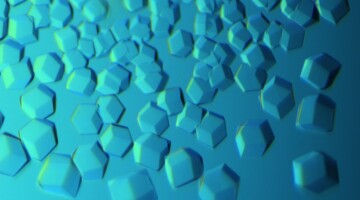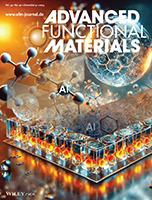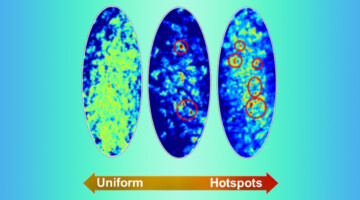Anaerobic SEC-MALS-SAXS at the SIBYLS beamline probes the conformational states behind electron bifurcation in the Thermotoga maritima EtfABCX, revealing insights on mechanisms at the thermodynamic limits of life. Shown are the bifurcation- and electron-conducting-like states experimentally observed for the first time in solution. Read more »
ALS Work Using Scattering/Diffraction
These techniques make use of the patterns of light produced when x-rays are deflected by the closely spaced lattice of atoms in solids and are commonly used to determine the structures of crystals and large molecules such as proteins.
Tracking Platinum Movement on Fuel-Cell Electrodes
Researchers tracked the movement of the platinum nanoparticles that catalyze reactions in polymer electrolyte fuel cells (PEFCs) and correlated this movement with nanoparticle degradation. The results yielded solutions that can immediately reduce platinum waste in emission-free heavy-duty fuel-cell vehicles. Read more »![]()
![]()
Computer-Aided Protein Design for New Biomaterials
Using a computer-based approach, researchers designed porous protein crystals that were revealed to be stable, tunable, and atomically accurate using x-ray scattering and diffraction at the ALS. The work provides a powerful new platform for biological materials engineering and opens up wide applications in biotechnology and medicine. Read more »![]()
![]()
Influences of Metal Electrodes on Stability of Non-Fullerene Acceptor-Based Organic Photovoltaics
Researchers investigate interfaces in an organic photovoltaic device, revealing that the aluminum (Al) top electrode undergoes thermally activated diffusion into inner layers forming ionic and organo-metallic-like species, compromising long-term device performance. Chemical degradation process is characterized by 27Al solid-state NMR and X-ray photoelectron spectroscopy. Read more »
Immune Response Spurs Growth of “Soft” Kidney Stones
Matrix stones are an unusual type of soft kidney stone closely associated with the presence of bacteria from unchecked urinary tract infections. Researchers conducted a comprehensive study of surgically extracted matrix stones, work that highlights how host defense mechanisms against microbes can simultaneously encourage harmful stone formation. Read more »
How Structure Affects the Activity of Lipid Nanoparticles
Berkeley Lab and Genentech scientists related the internal structures of lipid nanoparticles to their efficacy at drug delivery, using a combination of methods including x-ray scattering at the ALS. The work promises to expedite the development of drug delivery systems for the treatment of diseases such as COVID-19 and cancer. Read more »![]()
![]()
Accelerating Sustainable Semiconductors With ‘Multielement Ink’
Scientists have developed “multielement ink”—the first “high-entropy” semiconductor that can be processed at low temperature or room temperature. The new semiconducting material could accelerate the sustainable production of next-gen microelectronics, photovoltaics, solid state lighting, and display devices. Read more »
Insight into How Thermoresponsive Nanomaterials Work
By combining soft x-ray scattering with electron microscopy, researchers learned how nanoscale polymer assemblies in solution restructure in response to heating. The approach can be generalized to many complex, solution-phase, nanoscale processes, and holds promise for driving advances in applications from drug delivery to catalysis. Read more »![]()
![]()
Precisely patterned nanofibres made from extendable protein multiplexes
Superhelical symmetry can be found in helical repeat proteins, and de novo helical repeat proteins are rigid and amenable to stacking in a head-to-tail fashion, which is an important factor in building up coincident symmetries. Now, using cyclic helical repeat proteins, Baker and colleagues generate protein nanostructures—as depicted on the cover—with coincident cyclic and superhelical symmetry axes. Read more »
Fluctuations Mark Phase Changes in Magnetic Films
Researchers discovered that nanoscale spin fluctuations deep inside ordered states of a magnetic film can characterize phase transitions, independent of underlying magnetic interactions. The results provide a new way to predict and understand phase transitions in materials relevant to high-density, energy-efficient microelectronics. Read more »![]()
![]()
- « Previous Page
- 1
- …
- 4
- 5
- 6
- 7
- 8
- …
- 39
- Next Page »








